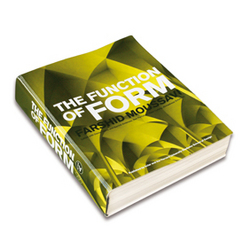TROPOLISM
Tropolism Books: The Function Of Form
 Title: The Function Of Form
Title: The Function Of Form
Author: Farshid Moussavi
Publication Date: Autumn 2009
Publisher: Actar
ISBN: 978-84-96954-73-1
Look, it's no secret I love Spanish architecture book publishers. Just look at my bookshelf: El Croquis (issues 49-69, baby!), Quaderns (193-203) and the awesome Documentos De Arquitectura series published by the Colegio de Arquitectos de Almeria (issues 17 and 32, if anyone can get me an issue 11 in this series drop me a line). That leaves out the new stuff, like the amazing and exhaustively detailed surveys from a+t. So it should come as no surprise that I love everything Actar has sent me, particularly their new title The Function Of Form, by Farshid Moussavi.
Rarely do we get books by practicing architects that are not about that architect's practice. Or if we do, it will be a book of poems or (shiver) watercolors. Yet here is one that is thoughful, useful, and only incidentally related to Ms. Moussavi's practice. Yet it is about architecture. The book is ostensibly a survey of distinct structural spanning systems, all of which contain repetitive structural members and variations on their arrangement, scale, or shape. I mean, Foreign Office Architects is of course interested in these specific kinds of structural systems, yet the book hardly favors any particular system. Instead, it illustrates the incredible variety and breadth of structural innovation that has happened over the last century or so. If one were to organize the book chronologically, I get the sense that one would find one chapter of pre-20th Century structural systems, one chapter of 20th Century, and one chapter of 21st Century.
Another powerful choice was having all the systems illustrated well, and in exactly the same way. This filter allows us to see that the innovations of Guarini in his SS. Sindone Chapel of 1667 are just as relevant today as they were in the Baroque era. And fans of ancient Arabic architects, rejoice: the immense contributions of this group to dome technology is no longer overlooked.
Most importantly, this book encapsulates our current era's structural concerns and obsessions as succinctly as John Borrego's Space Grid Structures did in 1968. While the latter boiled down the discussion of spaceframe structures into the real concern of the 60s (awesome grid structures everywhere!) by giving us a few pages of scaleless elements and diagrid paper, The Function Of Form ends each section of the book with miniature axonometrics which collect all the previously surveyed systems on one sheet. The effect is clear: tessellation rules.
Support this site by purchasing The Function Of Form here.
Advertisement
Support our advertisers because they help keep the content free.
If you're interested in advertising, contact us.
